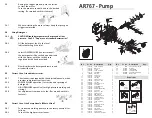
2.1.11
DO NOT tamper with or alter the calibration of the safety
valve. EXPLOSION HAZARD.
2.1.12
DO NOT alter the original diameter of the spray head
nozzle. OVER PRESSURIZATION MAY OCCURE.
2.1.13
DO NOT leave the cleaner unattended. ACCIDENT HAZARD.
2.1.14
DO NOT move the cleaner by pulling on the electrical cable.
SHORT CIRCUIT HAZARD.
2.2
Safety “MUSTS”
2.2.1
All electrical circuits MUST BE PROTECTED against the water
jet. SHORT CIRCUIT HAZARD.
2.2.2
The cleaner MUST ONLY BE CONNECTED to a ground fault
system. ELECTRIC SHOCK HAZARD.
• Use of a safety residual current circuit-breaker (R.C.C.B.) will
provide additional protection for the operator. (30 mA)
2.2.3
The high pressure may cause materials to bounce off
surfaces at speeds; therefore protective clothing and safety
goggles MUST BE WORN. INJURY HAZARD.
2.2.4
Before working on the cleaner, REMOVE the electrical plug.
ACCIDENTAL START UP HAZARD.
2.2.5
Before pressing the trigger, GRIP the gun fi rmly to
counteract the recoil. INJURY HAZARD.
2.2.6
COMPLY WITH the requirements of the local water supply
company. According to DIN 1988, power-jet cleaners may
only be connected to the mains drinking water supply with
a backfl ow preventer valve with drain facility is installed in
the supply hose. CONTAMINATION HAZARD.
2.2.7 A
qualifi ed technician MUST carry out maintenance and/or
repair of the electrical components. ACCIDENT HAZARD.
2.2.8
DISCHARGE residual pressure before disconnecting the
cleaner hose. Turn the water supply off and squeeze the
spray gun trigger. INJURY HAZARD.
2.2.9
Before each use. CHECK that all the screws are fully
tightened and that there are no broken or worn parts.
2.2.10
Only USE detergents, which will not corrode the coating
materials of the high- pressure hose/electrical cable and unit
components. EXPLOSION AND ELECTRIC SHOCK HAZARD.
2.2.11
ENSURE that all people or animals keep a minimum distance
of 16 yd. (15m) away. INJURY HAZARD.
Notes
Summary of Contents for AR767
Page 10: ...1 2 3 ...























